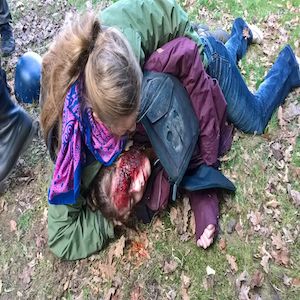One of the most popular areas on our website has been people checking for trauma assessment guidelines, so here is an updated version.
Please note that this is written for a very specific audience and is not necessarily the right guidelines for all. Please contact us [on info@lazarustraining.co.uk] if you have any questions or doubts.
Trauma Assessment guide 2020
- Safety & Scene Management
- Note time of arrival- let control know
- Check for safety- 1,2,3
- You [Gloves, glasses etc]
- Environment [cars, crowds etc]
- Patient [are they a threat- do a frisk or take a risk]
- Read the scene- ask what happened
- Consider the mechanism of injury
- CABCDE
- If required stabilize head and neck
- Knees if possible
- One-hand
- Equipment
- Four points of spine alignment
- Nose
- Sternum
- Nice bits
- Eyes looking forward
- Call for backup
- Talk to patient[s] to establish the level of consciousness
- Alert
- Verbal
- Pain
- Unresponsive
- If required stabilize head and neck
- Catastrophic bleeding
- Tourniquet- compressible
- Pack wound- junctional bleed
- Airway
- Is the airway noisy or silent- noisy is a partial obstruction
- Is the patient silent?
- Complete obstruction
- Normal breathing?
- Stopped breathing?
- Pocket mask/BVM/iGel
- Is there an obstruction?
- Bubbling=Fluid- turn then suction
- Snoring= Tongue- airway positioning
- Assess soft tissues of upper airway
- Lips
- Tongue
- Nose- [milk it for signs of bleeding]
- Larynx
- Assess the hard tissues of the airway
- Jaw
- Cheekbones [maxilla]
- Teeth & dental work
- Open mouth to look for bad stuff
- Clear the airway
- Create an airway
- Jaw thrust*
- Head tilt. Chin lift
- Chin lift
- Consider airway adjuncts
- NP [6 female 7 male]
- OP- “hands and plastic”
- Breathing
- Expose to the waistline- RVP FLASH
- R- Count the rate [goalposts 10-30]
- V- Assess volume and effort of breathing
- P- PUT OXYGEN ON
- FLASH
- Feel the chest [fractures]
- Look at the chest
- Holes
- Bruising [internal chest problem]
- Armpits [hidden injuries]
- Search the back, sides and shoulders- check clavicle
- Holes- seal them- vented one per side,
- Circulation
- Blood on the floor plus four more
- Chest
- Abdomen
- Pelvis
- Femurs
- Blood sweep
- Stop all external bleeding
- Tourniquet
- Pressure
- Direct
- Clotting agent
- Indirect
- Direct
- Elevation
- Windlass dressing
- Splint pelvis if unstable or suspected fracture
- DO NOT ROCK or SPRING
- Look for internal bleeding
- Pulse- check the radial pulse in both arms
- Is the rate good [less than 120 bpm]
- Is the volume good
- Shock- Skin colour- [pale and clammy]
- Recheck pulse- if no radial pulse raise legs to 45 degrees unless suspected fracture of pelvis or femur
- Blood on the floor plus four more
- Disability
- Assess LOC- repeat and record- trend over time
- Alert
- Voice
- Pain
- Unresponsive
- Assess LOC- repeat and record- trend over time
- Exposure & Evacuation
- Protect from elements
- Prepare evacuation
- Reassess and record
- Most important assessment is a reassessment
- If it’s not written down it didn’t happen
- Hand over using AT MIST format- [you have 30 seconds]
- Age
- Time of incident
- Mechanism of Injury
- Injuries found/suspected
- Signs and Symptoms
- Treatment given
- Document incident
- Restock

